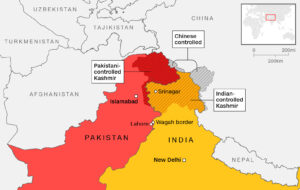“Operation Sindoor: A New Flashpoint in South Asia’s Volatile Border Tensions”

In a dramatic escalation of tensions between two nuclear-armed neighbors, India launched “Operation Sindoor,” a precision military strike targeting nine locations within Pakistan and Pakistan-administered Kashmir. According to initial reports from Indian defense sources, the operation was carried out in response to “credible intelligence” of militant infrastructure being used to facilitate cross-border attacks.
However, the consequences have been swift and severe. Pakistan’s government confirmed that Indian missile strikes hit six locations, resulting in the deaths of at least eight people and injuring more than 35 others. Islamabad has condemned the strikes as an “act of war,” vowing a “robust response” in both military and diplomatic forums.
The Operation and Its Immediate Impact

India’s Ministry of Defence has not publicly confirmed all details but has stated that the operation was aimed at neutralizing “strategic terror launchpads” believed to be responsible for a recent wave of violence in Jammu and Kashmir. These strikes, reportedly carried out by a combination of missile and drone assets, targeted areas in Muzaffarabad, Kotli, and other high-altitude military zones under Pakistan’s control.
On the other side, Pakistan’s Inter-Services Public Relations (ISPR) accused India of violating international norms and Pakistan’s airspace, labeling the assault as a direct provocation. According to Pakistani authorities, among the dead were civilians, including a child, and emergency services are still working to assess the full extent of the damage.
Regional Fallout and Global Concerns
Notably, this is the most serious flare-up since the 2019 Balakot airstrikes, which had already pushed both nations to the brink of a broader conflict. As expected, diplomatic channels have been activated urgently. China and the United States have issued statements urging restraint, while the United Nations has called for immediate de-escalation and a return to dialogue.
Moreover, with both countries possessing nuclear weapons, the situation has once again drawn sharp attention from global observers. Many fear that if cooler heads do not prevail, the consequences could destabilize not just the region, but broader global peace.
Historical Context and the Path Forward

Tensions between India and Pakistan have deep roots, particularly around the Kashmir region, which both nations claim in full but govern in parts. Since the revocation of Article 370 by India in 2019, relations have been particularly strained. Cross-border skirmishes, militant infiltrations, and proxy conflicts have become tragically routine.
However, what sets Operation Sindoor apart is its scale and the clear shift in doctrine—indicating a willingness by India to respond to perceived threats with overt military force. While India maintains its right to self-defense, Pakistan’s reaction underscores how quickly such actions can spiral into broader confrontation.
Conclusion: A Dangerous Precedent or Necessary Deterrence?
In conclusion, while Operation Sindoor may have been carried out with the objective of deterring terrorism, it undeniably sets a dangerous precedent for future engagements. As both nations dig in rhetorically and militarily, the international community must step up its mediation efforts. The alternative—a direct and protracted conflict between two nuclear states—remains a terrifying prospect that South Asia, and indeed the world, can ill afford.
https://www.independent.co.uk/news/india-pakistani-kashmir-b2746130.html

Leave a Reply